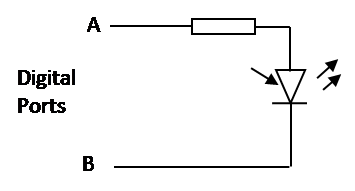How do I detect light with an LED?
Answer
It is possible to use a led as a light sensor as well as a light emitter. Essentially a reverse biased led will act as a capacititor, if it is then disconnected the charge will drain at a rate roughly proportional to the light hitting it.
We can use this with a microcontroller - utilising the multi state ability of the ports. 
The resistor should be about 100 ohms, I have only used this with red leds - it may work with others.
Use the following sequence:
Set Port A output high
set Port B output low // this makes sure the led is discharged
wait 1mS
set Port A output low
set Port B output high // reverse bias and charge
wait 1mS
set Port B as input // Port B is high impedance input
time how long for Port B to read low
The length of time will be dependant on the amount of light hitting the led.
There are several examples of this on the web - I will list them here as I find them again:
LED senses and displays ambient-light intensity
Red LEDs function as light sensors
Multi-Touch Sensing through LED Matrix Displays - very cool video
Very Low-Cost Sensing and Communication Using Bidirectional LEDs
No comments:
Post a Comment